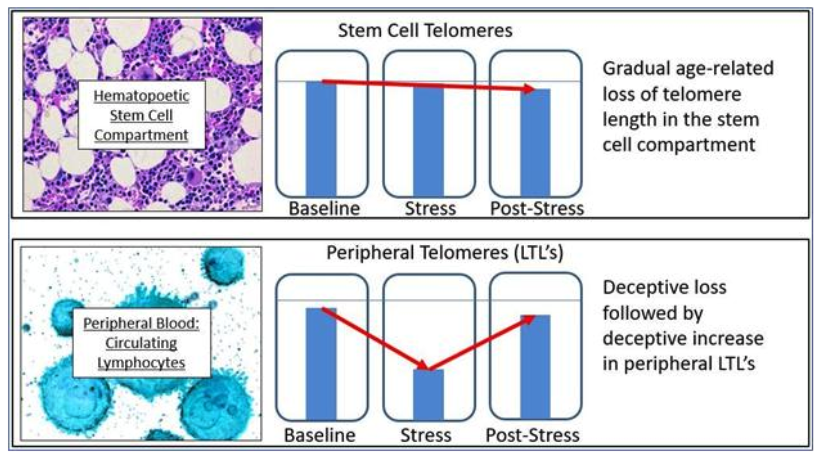Measuring blood cell telomere length: How useful?
Measuring blood cell telomere length (TL) has become a popular approach among researchers. Some even claim that you can extend your telomeres through meditation or exercise, but can we trust this measurement?
Not really.
Blood cell TL is a dynamic feature which during periods might undergo considerable losses and during other periods show stability or even be extended. These measurements reflect the mean TL of a number of immune cell subpopulations. And since the status of the immune system, i.e. cell activity, proliferation rate, cytokine levels etc., is not constant we would expect this to be reflected also in blood cell TL (Svenson et al., 2011).
As seen in this figure from Fossel (2018) it seems better if we were able to measure TL from Stem Cells (in this case from the Hematopoetic Stem Cell compartment).

Quoting Fossel:
“Even if the “average age” of the white cells (i.e., the average telomere length) has improved, it is not because we have relengthened any particular telomere, but because we are sampling a different and newer population of white cells. In short, serial sampling of peripheral white cells is not as reliable as we wish it were. In real life (i.e., in clinical measurements of peripheral white cell telomeres), it’s not as bad a watching an urban neighborhood over a fifty year period, but the assumption that we can relengthen telomeres in peripheral cells is usually based on wishful thinking rather than on an understanding of white cell population dynamics. We can certainly measure peripheral white cell telomere lengths over time, but interpreting differences in telomere lengths is chancy and should be taken with a grain of salt. It rarely means what researcher would like you to believe it means.”
I’m not saying though that exercise or meditation don’t help. Long exposure to chronic stress is detrimental for your telomeres, since cortisol downregulates telomerase activity (Choi, Fauce, & Effros, 2008). But saying that you can re-extend your telomeres and become younger it’s a whole different thing. You’ll be able to slow down your telomere loss, but in no way you are going to reverse human aging unless heavy clinical interventions become available (i.e. gene theraphy).
So blood cell TL has any use? It certainly has. One use case would be to assess your immune competence. If you have short telomeres in your immune cells you’re in a higher risk for getting an infection (Helby, Nordestgaard, Benfield, & Bojesen, 2017).
Hope this helps to make some clarifications 🙂
References
Choi, J., Fauce, S. R., & Effros, R. B. (2008). Reduced telomerase activity in human T lymphocytes exposed to cortisol. Brain, Behavior, and Immunity, 22(4), 600–605. https://doi.org/10.1016/j.bbi.2007.12.004
Fossel, M. (2018). Telomere Editorial - Perspectives on Telomeres and Aging. OBM Geriatrics, 3(1), 1–1. https://doi.org/10.21926/obm.geriatr.1901031
Helby, J., Nordestgaard, B. G., Benfield, T., & Bojesen, S. E. (2017). Shorter leukocyte telomere length is associated with higher risk of infections: a prospective study of 75,309 individuals from the general population. Haematologica, 102(8), 1457–1465. https://doi.org/10.3324/haematol.2016.161943
Svenson, U., Nordfjäll, K., Baird, D., Roger, L., Osterman, P., Hellenius, M. L., & Roos, G. (2011). Blood cell telomere length is a dynamic feature. PLoS One. https://doi.org/10.1371/journal.pone.0021485.t001